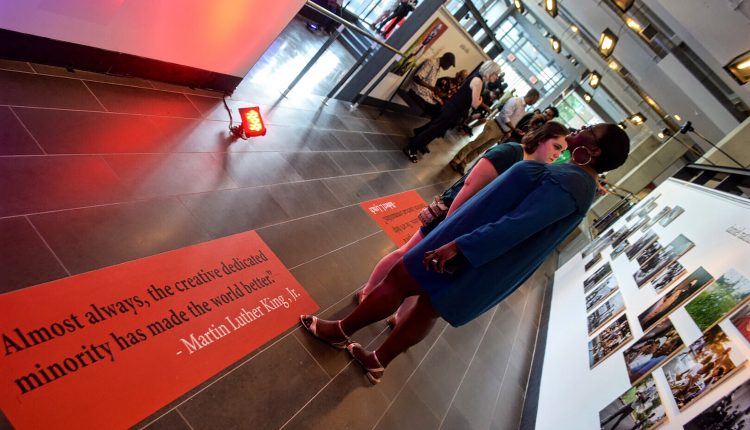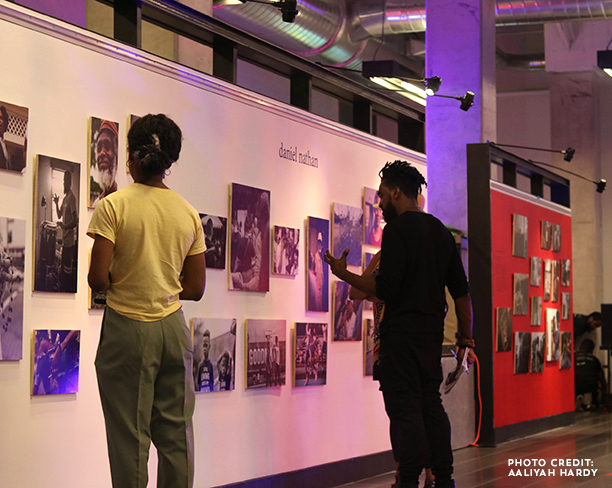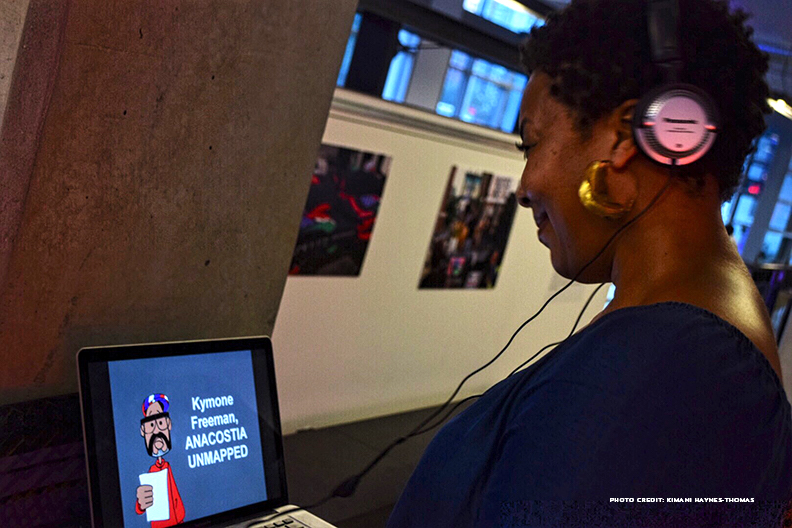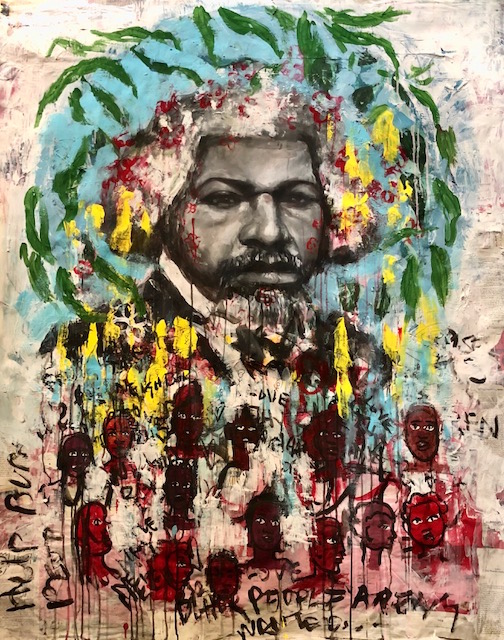
Artistic representation of Anacostia evolves from radio show into new exhibit
The 2016 radio series “Anacostia Unmapped” on WAMU helped introduce that Southeast DC neighborhood’s vibrant history to many listeners who had never set foot there, and it brought back memories for its longtime residents.

But a radio show, however stimulating to the senses, doesn’t do much for the eyes. Curators and artists from the neighborhood and beyond have created a workaround — a new exhibit, appropriately titled “Anacostia Unmapped 2.0,” open through Sept. 14 at the Commission on the Arts and Humanities Gallery at 200 I St. SE in Navy Yard. Interest in the project is high, with registrations for an artist talk at the gallery tonight already at capacity, a week after an invitation-only opening event.
“The stories were amazing stories,” said Karen Baker, the exhibit’s curator. “I also felt that we could expand upon them more and have an opportunity to tell them again through visuals.”
Baker runs the nonprofit Social Art and Culture, which partners with the Anacostia-based, independent We Act Radio, which also includes a TV component. She’s in the neighborhood every week, which put her last December in an ideal position to approach her longtime friend Kymone Freeman, an Anacostia activist who contributed to the 2016 NPR project, with another idea for celebrating the neighborhood’s history.
“We’re really extending the storytelling conversation into multimedia and mixed media art,” Baker said.
A new medium
Freeman’s first notion was to animate the story of “The Lion and the Map,” an award-winning piece from the original “Anacostia Unmapped 2.0” in which Freeman recounts his experience seeing a media report that included a DC map that entirely omitted the existence of Anacostia. The 2.0 project grew from there into a broader collection that gives visitors a feel for the neighborhood’s nuances.

Backed by a $25,000 grant from the DC Commission on the Arts and Humanities, the three-aisle gallery walk through the decades took seven months to assemble, with contributions from 12 local artists — some within the neighborhood as well as some with an outside perspective.
Visitors experience the history of Anacostia in sequence. After getting a chance to write positive affirmations on the “Chuck wall” — dedicated to Chuck Brown, local legend of the go-go music scene and frequent Anacostia visitor — viewers move through the era when Native Americans dominated the land, and then past artwork and objects that recall elements of the neighborhood’s past: the “Big Chair,” images of Cool “Disco” Dan, the Union Temple mural.
The second aisle is full of photographs, plus a banner signed by more than 200 attendees at Brown’s 2012 Howard Theatre wake. As the exhibit winds to a close in the third aisle, viewers get a glimpse of what Anacostia looks like now, with black-owned businesses lining Martin Luther King Avenue and Good Hope Road, collectively described by Freeman as “The Last Black Wall Street.”
The last section also includes a three-dimensional storm drain built by the Anacostia Watershed Society to model for visitors how pollution can slowly eat away at a neighborhood’s infrastructure. Just before exiting, viewers see the animation that got “Anacostia Unmapped 2.0” off the ground.
A standout piece
One striking subject in the gallery is that of the social reformer and abolitionist Frederick Douglass, who lived in Anacostia from 1877 until his death in 1895. The painting is the handiwork of Kenadi Johnson, 21, one of the exhibit’s artists who has never lived in Anacostia. She’s experienced it through the eyes of her great-aunt, who has lived minutes away in Capitol Heights for half a century. Baker knows Johnson’s mom, who immediately thought of her daughter upon hearing about the exhibit.

Johnson has been passionate about portraiture since she was 12, spurred by a private drawing class her grandfather urged her to attend. She started out visualizing famous singers she saw in magazines, then moved on to giving life to people she saw in her mind’s eye. Her challenge for “Anacostia Unmapped 2.0” was to bring her cerebral attention to detail and penchant for abstraction to a person of great significance for the Anacostia community.
A casual observer of Johnson’s final product might assume it was the result of careful planning. They would be wrong. Johnson said she envisioned the painting looking quite different, though she’s come to recognize that her artwork often takes on new dimensions throughout the process. In this case, she decided midway through painting to add cartoon-like images of faces around Douglass, and she abandoned her original idea to paint in color.
In all of her paintings, Johnson includes hidden words, some of which she covers up and others she leaves for the world to see. This time, she found herself writing “please help” and “love thy neighbor,” though even now she can’t quite articulate why these phrases came to mind.
“I paint with my mind,” Johnson said.
The project reminded her of her grandfather, who was the first African-American mayor of Rochester, N.Y., another place where Frederick Douglass once lived. Johnson hopes visitors to the gallery allow the painting to open similar emotional doors. The artist talk on Thursday night will offer visitors deeper glimpses into the creative process of Johnson and the other participating artists, Baker said.
What’s next?
Will there be an “Anacostia Unmapped 3.0”? Baker says yes — some people have already asked her to take the exhibit on tour, and plans are in the works to extend the animation component beyond its current 4.5-minute running time.
So far, the exhibit has had the exact effect on visitors that Baker hoped to see.
“If they had a perception or judgment, they were able to put that down when they walked out of there,” Baker said. “Whatever people think about Anacostia, whether they’ve heard about it or haven’t even stepped foot in Anacostia, they walk out and they feel a sense of beauty.”


Comments are closed.